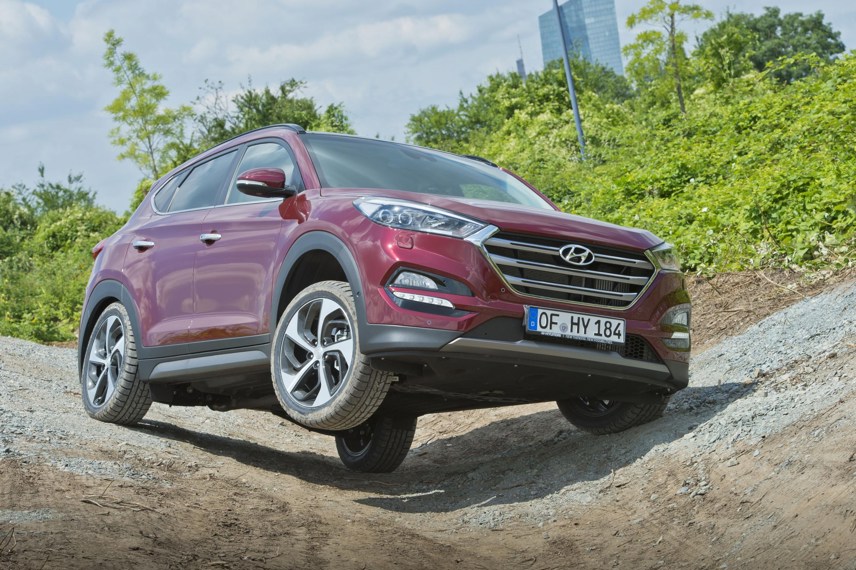Review
SUVs and crossovers are becoming increasingly important to car manufacturers as European customers seek alternatives to traditional saloons and hatchbacks.
For Hyundai, models such as the Santa Fe and, particularly, the ix35 have been key to its growth in the UK and in the fleet sector. For the ix35’s replacement, Hyundai is reverting back to the Tucson name, which is more in keeping with the larger Santa Fe SUV.
The key engine for fleets in the ix35 was the 116hp 1.7-litre CRDi, and this has been carried over. Previously, customers could choose this engine with front-wheel drive, or choose the 2.0-litre CRDi with all-wheel drive.
The 1.7-litre CRDi is still front-wheel drive-only, and now has CO2 emissions of 119g/km, putting it on a par with some of the best models in the class (although not as low as the 99g/km Nissan Qashqai and Renault Kadjar), while there is now a 136hp 2.0 CRDi with front-wheel drive and CO2 emissions of 127g/km. We weren’t able to try either of these on the media launch, with the test cars split between the new 185hp 2.0-litre CRDi 4WD, and the 177hp petrol 1.6-litre T-GDI 4WD, both with automatic transmission.
The high-power diesel is a strong performer, if a little over-powered for most fleet tastes. The seven-speed dual-clutch automatic is smooth and responsive.
The electronic power steering feels a touch over-assisted, and, with the lane-keeping assist pack on the test car, seemed to intervene pretty keenly when you weren’t sat in the dead centre of the lane. A bit disconcerting, but not a deal-breaker. And, of course, this and other safety features available (blindspot warning, autonomous emergency braking, and cross traffic alert) serve a useful purpose.
The entry level Tucson comes with digital radio, Bluetooth, USB and aux-in sockets, 16-inch alloy wheels, air conditioning and automatic headlamp activation. SE models have 17-inch alloys, rear parking sensors, heated front seats, lane-keeping assistance and dual-zone climate control. SE Nav models add Hyundai’s latest eight-inch touch-screen navigation system, featuring TomTom Live services, reversing camera and speed limit information display.
Premium models feature 19-inch wheels, leather seats, rear cross traffic alert, automatic windscreen wipers, blindspot warning and heated rear seats. Range-topping Premium SE also includes a heated steering wheel, keyless entry, self-parking (auto only), assisted tailgate opening, LED headlights, sunroof and ventilated front seats.
This raft of equipment, and the Tucson’s styling, certainly give the car the appearance of a premium model. But it is let down by the plain appearance of the interior, as well as the feel of some of the plastics (even compared to the Santa Fe).
It isn’t as complete a package as the Nissan Qashqai or Renault Kadjar, but still appeals as an upmarket looking alternative with a five-year/unlimited mileage warranty.
View our gallery or compare running costs
Author:
Simon Harris
Specs
| Manufacturer | Hyundai |
| Model | Tucson |
| Specification | Tucson SUV 4wd 2.0CRDi 136 DPF €6 Premium SE 6Spd 15MY |
| Model Year | 0.00 |
| Annual VED (Road tax) | £0 |
| BIK List Price | £30,690 |
| CO2 | 139g/km |
| BIK Percentage | 29% |
| Insurance Group | N/A |
| CC | N/A |
| Fuel Type | Diesel |
| Vehicle Type | SUV and Crossover |
| Luggage capacity (Seats up) | 5litres |
Running Costs
| P11D | £30,690 |
| Insurance group | N/A |
| Fuel Type | Diesel |
| Cost per mile | 85.60ppm |
| Fuel | 9.37ppm |
| Depreciation | 74.72ppm |
| Service maintenance and repair | 1.51ppm |
Info at a glance
-
P11D Price
£30,690
-
MPG
54.3 -
CO2 Emissions
139g/km -
BIK %
29% -
Running cost
3 Year 60k : N/A 4 Year 80k : N/A -
Fuel Type
Diesel
















